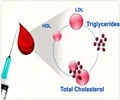Differences between the sexes as related to fat profiles are reported in a long-term lifestyle study.

The researchers found that men in social classes (based on occupation) with manual jobs had lower cholesterol levels than their counterparts in non-manual social classes. In contrast, women's LDL-cholesterol levels were more closely tied to their educational level than men.
The study highlights the health inequalities that exist between the social classes, and the researchers believe that future interventions should focus on men and women separately and explore the reasons for these differences, in order to promote better health.
Researchers from University of Cambridge performed a cross-sectional study as part of the European Prospective into Cancer involving 22451 participants aged 39-79 years old from the from Norfolk cohort in the UK. Each participant indicated what their alcohol consumption was and their BMI was calculated. Participants completed a survey that measured socioeconomic status using three factors: social class, education level, and the level of deprivation in the area they lived. This is the first time that socioeconomic status has been looked at assessing these three factors independently. Blood samples were also taken to determine the following lipid levels: total cholesterol, HDL-cholesterol, triglycerides, and LDL-cholesterol.
Kay-Tee Khaw, lead researcher, says: "There is a well-recognised social gradient in cardiovascular disease. We were interested in trying to understand reasons for the observed socioeconomic inequalities in health. However, there are different measures of socioeconomic status including occupational class, educational status and residential deprivation, which may relate differently to different domains of health."
Overall, women were found to have higher total cholesterol levels than men. In men, socioeconomic status was not initially associated with total cholesterol level, but after taking age into account, , men in manual social classes were found to have slightly lower total cholesterol than those in non-manual jobs. Women with a lower education level were found to have higher total cholesterol compared to others.
Advertisement
For LDL-cholesterol – the 'bad' cholesterol – again women were found to have higher levels than men. Women without educational qualifications beyond the age of 15 had significantly higher LDL-cholesterol than those who did even when accounting for BMI and alcohol use. Occupational class and level of deprivation were not linked to LDL-cholesterol in women. No association was found between the three socioeconomic indices and LDL-cholesterol levels in men.
Advertisement
Kay-Tee Khaw says: "We observed sex differences in the lipid patterns according to social class and education. The association of some adverse lipid parameters with social class and in particular, educational status in women was much stronger than for men. If we wish to reduce health inequalities we need to understand the reason for these health inequalities. Future studies need to look at men and women separately and explore the reasons for these sex differences."
Source-Eurekalert













